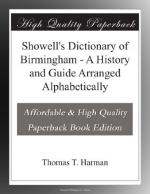Reform Leagues.—The first local affair of this kind that we have note of (though likely enough there had been “reform clubs” before that date) seems to have originated at a meeting of some dozen or so gentlemen at the Royal Hotel, Dec 14, 1829. On the 25th of Jan., 1830, a public meeting to organise a kind of local political body was held at Beardsworth’s Repository, and it is chronicled that about 15,000 persons were present. The result was the formation of the celebrated Birmingham Political Union, though the full name was “The General Political Union between the Lower and Middle Classes of the People.” The Union’s “Petition of Rights” was issued Dec. 13, and the “Declaration of Council” Dec. 20, 1830. This is not the place to enter upon a history of the doings of the Political Union, which was dissolved by mutual consent of the leaders May 10, 1834, but there can be no doubt that it did have considerable influence on the political changes of the period. In 1848 an attempt was made to resuscitate the Old Union, though the promoters of the new organisation called it the “Political Council,” and in 1865 another League or Union was started, which has a world-wide fame as “The Caucus.” Indeed, it may be safely said the town has never, during the past sixty years or so, been without some such body, the last appointed being the “Reform League,” started Sept. 2, 1880, by the Rev. Arthur O’Neill and his friends, to agitate for a change in the Constitution of the House of Lords.
Reform Meetings.—We have had a few big meetings of the kind one time and another, and give the dates of the principal. Newhall Hill used to be the favourite spot, and the first meeting held there was on January 22, 1817.—On July 22, 1819, there were 60,000 there, and a member was chosen to represent the town in Parliament. (See “Newhall Hill.”) The meeting of October 3, 1831, had only 150,000 persons at it, but May 7, in following year, saw 200,000 on the Hill.—The “great” Reform meetings at Brookfields were on August 27, 1866, and April 22, 1867.—A procession to, and demonstration at Soho Pool, Aug. 4, 1884, at which 100,000 persons are said to have been present, is the last big thing of the kind.
Regattas.—Usually the A1 amusement of places blessed with sea or river space, but introduced to us (Aug 2, 1879), on the Reservoir, by the Y.M.C.A., whose members had to compete with some crack rowers from Evesham, Shrewsbury, Stratford, Stourport, and Worcester.
Registers.—At what date a parish register was first kept here is not known, but Mr. Hamper, the antiquarian, once found some old parts stowed away under the pulpit staircase, and he had them bound and preserved. There are very few perfect registers in this neighbourhood, though Aston can boast of one dated from 1544, King’s Norton 1547, Handsworth 1558, Northfield 1560, Castle Bromwich 1659, and Moseley 1750—The Registration Act was passed Aug. 17, 1836.




